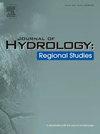2018年后喀拉拉邦洪水风险评估综述:方法方法、差距和未来方向
IF 5
2区 地球科学
Q1 WATER RESOURCES
引用次数: 0
摘要
研究区域该研究的重点是印度西南部的喀拉拉邦。喀拉拉邦由14个区组成,每个区都以地形、气候和土地利用模式的变化为特征。本综述批判性地分析了喀拉拉邦洪水风险评估(FRA)的文献,特别是在2018年毁灭性洪水之后。喀拉拉邦在21世纪经历了零星的洪水,这是由局部强降雨、快速城市化和水资源管理不当造成的。2018年喀拉拉邦洪水是近年来最具灾难性的洪水之一。几乎所有14个县都受到影响,480多人丧生,100多万人流离失所。人为因素,如对湿地的侵占、河床的采砂以及城市地区排水系统的不足,都加剧了洪水的影响。尽管喀拉拉邦的洪水历史悠久,但其洪水管理一直在努力跟上这些事件日益增加的规模和频率。过时的基础设施、不协调的水坝管理和糟糕的城市规划等因素加剧了洪水的影响。在此背景下,本关于喀拉拉邦洪水风险评估(FRA)的综述评估和综合了现有的方法,以提高对喀拉拉邦当前最先进的洪水风险评估的理解,并为更有效的洪水管理战略提供基础。该综述指出,2018年洪水后开展的研究可分为三大方法论主题:遥感和地理信息系统(GIS)、预测建模(包括水文和水力模拟)和分析方法(如机器学习、统计方法和多标准决策)。研究的空间焦点揭示了显著的差异,Allapuzha是研究最广泛的地区,而Thiruvananthapuram受到的关注最少。该综述确定了文献中的关键空白,包括翻译缓解战略方面的挑战、土地利用规划不当导致的城市洪水、各种洪源整合不足以及对复合极端事件的研究有限。文章强调了将危害量化转化为缓解和整合气候变化预测的紧迫性,为喀拉拉邦的森林资源评估提供了进一步研究的途径。本文章由计算机程序翻译,如有差异,请以英文原文为准。
A critical review of flood risk assessment in Kerala Post-2018: Methodological approaches, gaps, and future directions
Study region
The study focuses on Kerala, a state in the southwest of India. Kerala is composed of 14 districts, each characterised by variations in topography, climate, and land use patterns.
Study focus
This review critically analyses the literature on flood risk assessment (FRA) in Kerala, particularly after the devastating 2018 floods. Kerala has experienced sporadic floods in the 21st century, caused by localized heavy rainfall, rapid urbanization and improper management of water resources. The 2018 Kerala Floods was one of the most catastrophic recent floods. Nearly all 14 districts were affected, over 480 people lost their lives, and more than a million were displaced. Anthropogenic factors, such as encroachment on wetlands, sand mining in riverbeds, and inadequate drainage systems in urban areas, have worsened the impact of floods. Despite the long history of flooding, flood management in Kerala has struggled to keep pace with the increasing magnitude and frequency of these events. Factors such as outdated infrastructure, uncoordinated dam management, and poor urban planning have exacerbated the impacts of floods. Against this backdrop, this review on flood risk assessment (FRA) in Kerala evaluates and synthesises existing methodologies to improve understanding of current state-of-the-art FRA in Kerala and provide a foundation for more effective flood management strategies.
New hydrological insights for the region
The review identifies that research conducted after the 2018 floods can be categorised into three broad methodological themes: Remote Sensing and Geographic Information Systems (GIS), Predictive Modeling (including hydrological and hydraulic simulations), and Analytical Approaches (such as machine learning, statistical methods, and multi-criteria decision-making). The spatial focus of the studies reveals significant disparities, with Allapuzha being the most extensively studied district and Thiruvananthapuram receiving minimal attention. The review identifies critical gaps in the literature, including challenges in translating mitigation strategies, urban flooding stemming from poor land use planning, insufficient integration of various flood sources, and limited research on compound extreme events. Highlighting the urgency of translating the quantification of hazard to mitigation and the integration of climate change projections, the article provides avenues for further research for FRA in Kerala.
求助全文
通过发布文献求助,成功后即可免费获取论文全文。
去求助
来源期刊

Journal of Hydrology-Regional Studies
Earth and Planetary Sciences-Earth and Planetary Sciences (miscellaneous)
CiteScore
6.70
自引率
8.50%
发文量
284
审稿时长
60 days
期刊介绍:
Journal of Hydrology: Regional Studies publishes original research papers enhancing the science of hydrology and aiming at region-specific problems, past and future conditions, analysis, review and solutions. The journal particularly welcomes research papers that deliver new insights into region-specific hydrological processes and responses to changing conditions, as well as contributions that incorporate interdisciplinarity and translational science.
 求助内容:
求助内容: 应助结果提醒方式:
应助结果提醒方式:


